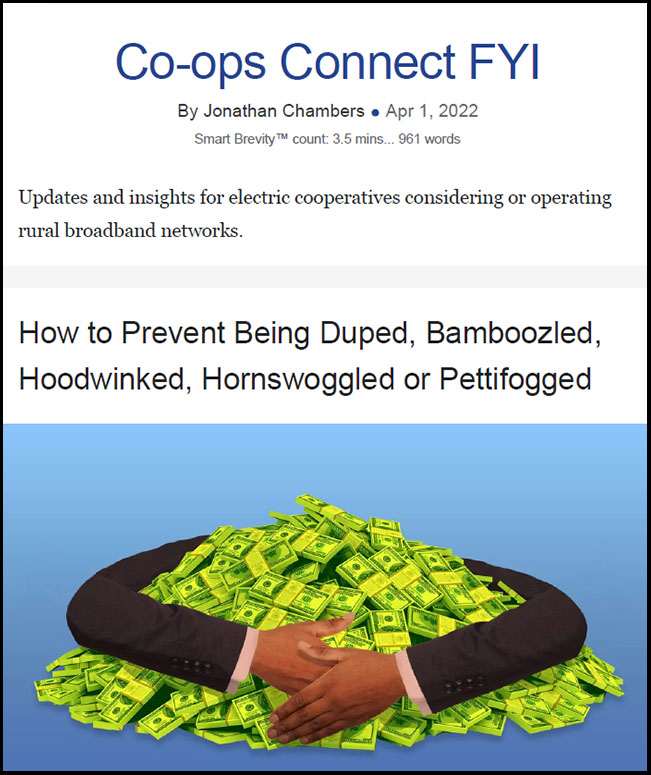How to Prevent Being Duped, Bamboozled, Hoodwinked, Hornswoggled or Pettifogged
April 1, 2022
The government plans to spend tens of billions in public funds.
Can waste, fraud, and abuse be far behind?
In my time at the FCC, I was involved in the reforms of every FCC spending program, each of which had been the target of fraud or scams.
- These were programs meant to achieve noble purposes: assistance for the deaf, the poor, rural areas, schools, libraries, those left behind in the internet transformation.
- And yet: Unscrupulous companies preyed on the public funding, harming both the general public and the very communities the programs are designed to help.
- The same problems seem to arise with new every program. It didn’t take long for the FCC’s Emergency Broadband Benefits program to attract fraud. Within months, the FCC’s Inspector General had issued a warning.
The bottom line:
With over $10 billion being spent on broadband through the American Rescue Plan Act and another $65 billion from the Infrastructure Act, the fraudsters are coming.
Funding for rural broadband has been described as a land rush or a gold rush. Here’s my guide on distinguishing between gold and fool’s gold.
Follow the Missouri mantra: Show me.
“I come from a state that raises corn and cotton, cockleburs and Democrats, and frothy eloquence neither convinces nor satisfies me. I'm from Missouri, and you have got to show me.”
— William Vandiver
If you are an electric co-op planning to invest in a broadband network:
Any Excel spreadsheet monkey can put together a broadband business plan.
The big question: Is the business model based on actual materials and labor pricing and proven take rate projections?
Specifically:
- Show me the unit pricing for materials and labor that matches your projections.
- Show me a schedule for delivery of materials, certified by a fiber manufacturer and distributor.
- Show me a schedule for construction, certified by a construction firm that has available resources.
Go deeper:
Then, show me at least 20 electric cooperative fiber broadband projects using this model. Better yet, show me 50. Show me a comparably sized cooperative where fiber service has been deployed.Show me the comparison of a business plan and its execution. Show me a similar project somewhere else, with a comparable number of miles and members.
By the numbers:
- Show me the projections and actual cost of construction. Show me the projections and actual schedule of construction.
- Show me the projections and actual service tiers, take rates, and revenues.
- Show me the projections and actual operational costs.
If you are a state broadband office or county official:
Vet applicants using objective criteria, including demonstrated capability to construct and operate the size and type of network and level of service proposed in the application.
In short: Have the applicants ever done with private money the thing they want to do with public money?
Specifically:
- Show me fiber design maps for the network.
- Show me proof of availability of materials and construction labor.
- Show me a completed project, comparable in number of miles, population density, and schedule of construction.
- Show me the take rates in an existing service area to demonstrate the service is desired at the speed tiers and price points.
- Show me current participation in a federal or state universal service program, ETC certification or compliance with the Affordable Connectivity Program.
Go deeper:
To make the vetting and oversight easier, approve applications for only a single year’s construction.
- An annual process will result in a more orderly, systematic build-out and will be simpler to administer and monitor.
- Specifically:
- Show me an existing comparable project where, in a single year, the applicant built out the same number of miles and served the number of homes as in the application.Show me proof of access to design, materials, and construction labor that will be available in the upcoming year.
- Show me existing public support for the type of service at the speed tiers and prices you intend to offer.
Final Thoughts
There is a downside to the large and sudden increase of public funding for broadband.
- Public money attracts fraud.
- A mismatch between need and funding will attract those whose financial incentive is inconsistent with serving rural America.
- Inadequate vetting means the problems aren’t detected until it’s too late.
The RDOF auction proved that. Think about it:
- Elon Musk needs more taxpayer funding?
- Were there really multiple companies that wanted to build and operate Gigabit networks in every rural census block in the country?
- Where has everybody been all these years?
- Is it believable that eight or nine companies wanted to build and operate a fiber-to-the-home network in rural Missouri, where no one has ever shown interest?
- One of the bidders was financed by the Ontario, Canada, Teachers’ Pension Plan. Really? I’d like to invite the manager of one of these funds to visit with the folks who live here.
The bottom line:
There are precious few companies with a track record for building and operating fiber networks in rural America. “Free” money will bring out the consultants and conmen, the hucksters and flim flam artists.
Vet them, or the moment to build fiber across rural America will be lost.
“One of these days in your travels, a guy is going to show you a brand-new deck of cards on which the seal is not yet broken. Then this guy is going to offer to bet you that he can make the jack of spades jump out of this brand-new deck of cards and squirt cider in your ear. But, son, do not accept this bet, because as sure as you stand there, you're going to wind up with an ear full of cider.”
— Sky Masterson, “Guys and Dolls”
